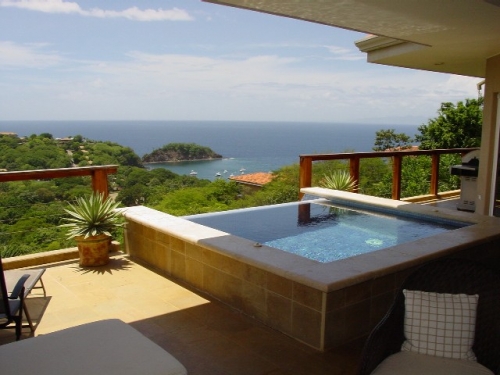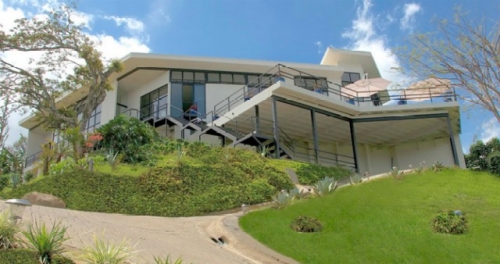Costa Rica Guide
Costa Rica Real Estate
List your property today!
Inclusion of real estate listings at Costa Rica Guide is
absolutely free of charge.
Featured Properties
Costa Rica Guide - Costa Rica Real Estate
Costa Rica
Natural beauty and friendly business climate
Latin Trade
July, 1 2001
It's often said that there's no place in the world like Costa Rica: active volcanos, carefully protected rain forests, secluded beaches and undersea coral reefs. A small mountainous country on the narrow Central American isthmus, Costa Rica enjoys an immense diversity of climates, environmental regions and plant and animal life. But it is also gaining in importance as a strategic business center, with easy access to world markets and friendly investment policies.
Located in the middle of the American Continent, Costa Rica lies between Panama to the south and Nicaragua to the north, with its Pacific and Atlantic coasts merely 175 miles apart. Costa Rica has a well-developed tourism infrastructure, ranging from luxurious beachfront hotels to locally run lodges that provide a base for exploring the pristine mountains and rain forests.
Costa Rica welcomes hundreds of thousands of visitors each year to share its peaceful beauty and natural treasures. This peaceful Central American nation also hosts hundreds of meetings and conventions annually through its nationwide network of resorts and other hospitality facilities. Ticos, as Costa Ricans are commonly known, know their country is a special place and go out of their way to accommodate visitors, pointing them in the right direction, explaining the local customs and helping to ensure an enjoyable stay.
Most international visitors arrive at the recently remodeled Juan Santamaria International Airport located in Alajuela, 20 minutes from the capital city of San Jose. Last year, the airport posted 769,000 international arrivals, including 375,000 from the United States, 130,000 from Europe and 87,000 from South America.
Costa Rica is the oldest democracy in Latin America. The nation's armed forces were abolished in 1948, and those resources have since been devoted to education, personal health and an emerging broad middle class. The United Nations' Human Development Index has classified Costa Rica as the country with the best quality of human resources among developing nations.
So Many Things to Do
The biggest challenge that visitors to Costa Rica face is choosing how to spend their vacations with so many choices available. Here are some of the options.
Beaches
Beach lovers can select the perfect spot to unwind along Costa Rica's more than 621 miles of shoreline. Each beach has a beauty and character all its own. Costa Rica's many beaches are part of the national park system, which adds to their attractiveness, since visitors can enjoy the beauty of the tropical countryside as well.
Snorkeling and Diving
Few places in the world have such a profusion of underwater beauty as is found in the waters of the Caribbean in the east and the Pacific Ocean in the west. This beauty makes Costa Rica one of the most attractive international destinations for snorkeling and diving, with numerous dive centers offering rental equipment and organizing tours. The most beautiful areas are found around the Coco and Cano islands, but because of their distance and wealth of protected species, special permits and transportation are needed to get there. The Papagayo Gulf in Guanacaste and the southern Caribbean also are noteworthy because of the large number of spectacular coral reefs.
Sport Fishing
Costa Rica is known throughout the world for the richness and diversity of its sportfishing, including marlin, sailfish, tuna, rooster fish and snapper on the Pacific, and snook, sea bass, mahi mahi (dolphin fish) and snapper on the Atlantic side.
Anglers can also enjoy their sport in mountain lakes and in some rivers.
Surfing
It's no accident that Costa Rica has become one of the primary destinations for surfers. The easy access to the oceanside and the variety of surf are very attractive to lovers of the sport. Four different areas on the Caribbean and the North, Central, and Southern Pacific coasts offer the best in surfing.
Windsurfing
World champions have called Costa Rica one of the globe's top five windsurfing spots. From anywhere in the country, the warm surf is only a few hours away. There are river mouth breaks, beach breaks, reef and one of the longest left-hand curls in the world.
Rafting
Rafting on Costa Rica's wild and scenic rivers is perhaps the single most popular adventure sport in the country. Professional equipment and guides are available so visitors can enjoy the Reventazon, Pacuare, General or Corobici rivers to the utmost. Whitewater kayaking is another favorite, and Costa Rica has hosted more than one international tournament. Ocean kayaking is also rapidly gaining devotees.
Volcanos
Visitors can enjoy Costa Rica's volcanos, but judiciously. The Arenal Volcano is one of the most active in the world, with an eruption on the average of once per hour. The dormant Irazu Volcano offers breathtaking views. The inactive Poas Volcano has the largest crater in the world.
Historic Sites
The San Jose metropolitan area boasts many historic sites, including the National Theater, the National Museum, the Post Office, the Atlantic Railway Station, the Cathedral, the Central Park, the Metallic Building, the Central Market, the CENAC (Arts and Culture Center), the National and Morazan Parks, the Melico Salazar Theater and the Children's Museum. In the outlying areas, sites of interest are the Orosi Church and the ruins of the Ujarras Church, both in Cartago Province. Anyone who enjoys archeological sites should visit Turrialba in Cartago Province to see the Guayabo National Monument.
Information for Travelers
Lodging
Visitors to Costa Rica can choose from a wide variety of lodging, from luxury hotels belonging to major worldwide chains to ecological hostels and more modest bed-and-breakfasts.
Cuisine
What's on the menu? Costa Rican cuisine ranges from the freshest tropical fruits and vegetables to exquisite seafood and indigenous foods, such as gallo pinto, consisting of rice lightly sauteed with beans and served with steak or eggs. Costa Rican dishes also include tamales, arroz con pollo (rice with chicken), minced arracache root, potato and meat hash, and casado, a "marriage" of rice, beans, ripe plantains, fresh vegetable salad and some sort of meat. The list goes on to include grilled corn on the cob, chorreadas (a thick johnny cake made from tender corn), and empanadas filled with cheese, beans or meat. In addition, if a visitor so desires, he or she may try other cuisines, such as French, Italian, German, Korean, Chinese, Spanish, Mexican, U.S. and vegetarian, all of which are well-represented in the country.
Communications
Costa Rica has one of the most advanced telecommunications systems in Latin America, with telephones and fax machines all over the country and an increasing number of businesses online. To call or fax Costa Rica, dial the country code 506 before the number. Mail service is reliable, and San Jose has an ample selection of courier services. Most large hotels in the San Jose area have cable television. Newspapers and magazines from North America and several European nations are sold in many shops and hotels in and around the capital.
Transportation
It's easy to get around in Costa Rica. There is bus service to just about every town and city, and buses that serve main tourist destinations are of high quality. Taxis are also plentiful and inexpensive, and in San Jose, they are required to use meters for most trips. The standard charge for a taxi between the international airport and downtown San Jose is US$10. The quickest way to get around is to fly, and several domestic airlines offer daily flights to most of the popular tourist destinations. There are also plenty of car rental agencies, most of which rent four-wheel-drive vehicles.
Banks and Money
State and private banks abound in San Jose, and at least one major bank is located in every large town. The official currency of Costa Rica is the colon, but U.S. dollars are accepted in most hotels and restaurants. U.S. dollars and traveler's checks can be changed in banks and hotels. Major credit cards are widely accepted, and cash advances can be obtained in San Jose.
Business Hours
Government offices are generally open from 8 a.m. to 4 p.m., while banks close any time between 3 and 6 p.m., depending on the branch. Most shops are open from 9 a.m. to 6 p.m., while some open at 8 a.m. and others close at 7 p.m.; most grocery stores close at 8 p.m. Some shops also close for lunch, between noon and 1 or 2 p.m.
Holidays
Though government offices and most banks close for national holidays, travelers are not inconvenienced since they can change money or travelers checks in their hotel. Do not change money on the street. During the week of the Annexation of Guanacaste, July 25, the main towns in the northwest province of Guanacaste are overflowing with revelry and folklore. Carnival, which is celebrated in the Caribbean port of Limon during the week of October 12, is another colorful affair.
Entry Documents
Anyone who wants to visit Costa Rica should contact the Costa Rican embassy or consulate in their country to determine what kind of documents are needed to enter the country.
Climate
Costa Rica has only two different seasons: a rainy season that runs from May to November and a dry season that begins in December and ends in April. The average temperature in the Central Valley is 72[degrees] F (22[degrees] C), while on the coast and at the beaches it ranges from 70[degrees] to 90[degrees] F (21[degrees] to 32[degrees] C).
Business Advantages
Costa Rica's strategic position in the heart of the western hemisphere, the government's positive attitude toward new business transactions, the infrastructure, access to international markets and the quality and cost of its labor make this country an ideal place to establish commercial operations.
Costa Rica's political and economical stability has fostered one of the most reliable and transparent business climates in the Americas. Fiscal incentives are offered, as well as a highly skilled labor force (95% of the population is literate), making high-quality operations available at competitive operational costs.
Costa Rica places no limits on repatriation of profits and of original investment. There is a tax of a 15% on dividend remittances, but this does not apply to companies established in free zone areas.
As befits the country's location, air and ocean freight transportation services are provided to major U.S., Mexican, Central American, South American and Caribbean ports and cities. This makes the country a superb strategic base for world markets, especially for the distribution of products to the Caribbean basin.
Coffee has historically been the country's most important crop, and Costa Rica continues to produce some of the best coffee in the world. But in recent years, less traditional crops have been playing an increasingly important economic role. The banana is the second most important export crop, with vast plantations covering parts of the Caribbean lowlands, but there is also significant land dedicated to pineapples, sugar, oranges, rice, cattle, hardwoods and ornamental plants.
Costa Rica's positive business environment fosters long-term planning for multinational corporations that seek to establish or expand operations in a country that has consistently been rated as having one of the lowest risk ratings for investment. With its high level of education and telecommunications system, Costa Rica has attracted multinational technology investments from companies like Intel Corporation, Laser Sight Technology, Siemens, Procter & Gamble and many others.
Ten great reasons to visit Costa Rica
* Natural, unspoiled beauty
* Unique rain forests and national parks
* Active volcanoes to explore
* A sport fishing paradise
* Snorkeling and diving trips
* 621 miles of Caribbean and Pacific beaches
* Convenient flight connections with the United States, Europe and Latin America
* Well-developed tourism industry
* Political and economic stability
* Numerous resorts and meeting facilities
SOURCE: Costa Rica Tourist Board (www.tourism-costarica.com)
Facts About Costa Rica
LOCATION: Costa Rica is bordered on the southeast by Panama, on the north by Nicaragua, on the east by the Caribbean Sea, and on the west by the Pacific Ocean.
POPULATION: 4,000,000
AREA: 51,100 square kilometers (31 ,682 square miles)
CAPITAL: San Jose
OFFICIAL LANGUAGE: Spanish
MONEY: Colon
OFFICIAL RELIGION: Catholic
POLITICAL SYSTEM: Democracy
ELECTRICITY: 110 volts
NATIONAL BIRD: Yiguirro
NATIONAL FLOWER: Purple Guaria Orchid
NATIONAL TREE: Guanacaste
HIGHEST ELEVATION: Cerro Chirripo (Mount Chirripo) at 3,820 meters (12,530 feet) above sea level
Eco-tourism: A unique destination
Costa Ricans have preserved their nation's invaluable biodiversity in protected areas covering fully one-quarter of the country. Costa Rica is often cited as a model for conservation in harmony with community development and economic growth. At the same time, access to nature is easy: In one day, a visitor can drive to the very edge of a volcanic crater, hike through the heart of a mountain jungle, take an aerial tram ride in the rainforest canopy and soak up sun on a deserted beach.
Costa Rica's nine active volcanos vividly remind visitors of the awesome power contained in the earth's thin mantle. The forests on the upper slopes of Costa Rica's mountains and volcanos are frequently draped in mist and clouds. Mosses and lichens get a foothold on the constantly wet surfaces, providing a home for orchids, bromeliads, ferns and innumerable other plants. The cloudforest captures the imagination, emanating a sense of ancient and enduring life.
In the foothills and lowlands of both slopes, Costa Rica's rainforests harbor thousands of known life forms and thousands more yet to be described. They are among the last strongholds of biodiversity on earth. At dawn, the rain forest resonates with birdsong; in the heat of the day, it is quiet. Walking in the rainforest is like taking a step back in time, where the modern world and all its stress fade into insignificance.
Costa Rica has an estimated 850 bird species, including hawks, ducks, toucans and tanagers, plus the noisy parrots and macaws. Monkeys, coatimundis, peccaries, agoutis, armadillos, sloths, deer, squirrels and bats are commonly seen mammals. Also frequently found are iguanas, crocodiles and many species of lizards.
For the most fulfilling experience in the forest, it is important to go with an experienced naturalist as your guide, who will explain the complex inter-relationships of species in the forests, help identify birds and spot well-camouflaged creatures.
Costa Rica's National Parks System protects examples of nearly all the ecosystems that exist in the country, covering about 14% of the national territory. Those parks and protected areas are not only great places for hiking and observing wildlife, but some also include great spots for skin diving, spelunking, surfing and other outdoor activities.
No matter what your vacation priorities are, a visit to one or more of the national parks or other protected areas is time well spent. Admission to any national park costs US$6.
Copyright 2001 Freedom Magazines, Inc.
Note: The above information is not to be used for any other purpose other than private study, research, criticism or review. Thank you.






